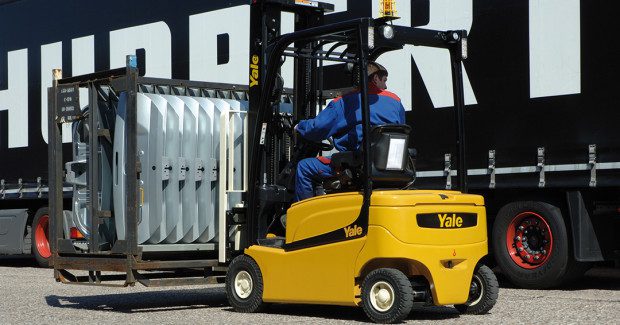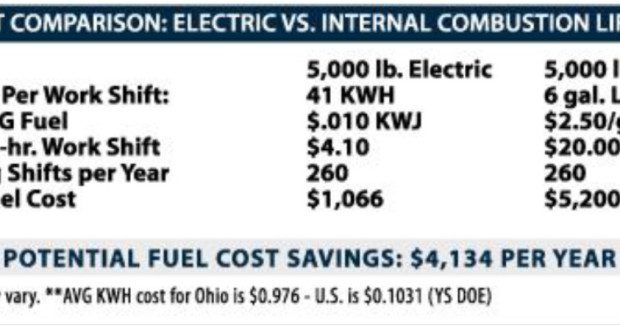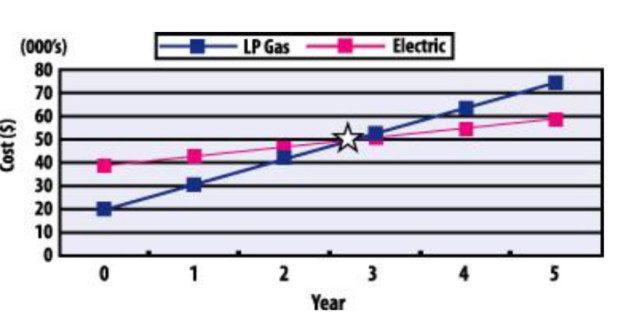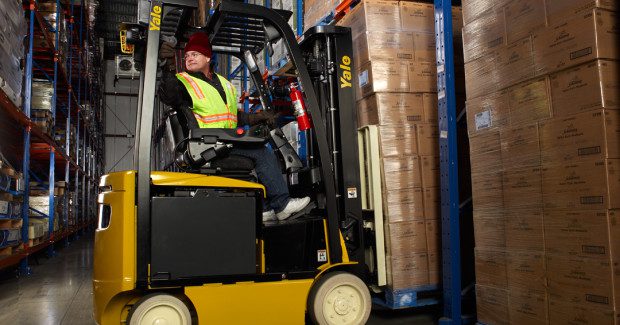The Truth About Electric Lift Trucks
Though electric lift trucks are not suitable for every application, economic and environmental changes are advancing their opportunities. This review of those changes analyzes the impact they might have when considering an electric lift truck for your shop.
Posted: February 25, 2015
It is true that electric lift trucks are not suitable for every application. Throughout the past decade, however, there have been a number of changes in the lift truck industry and the material handling work environment that have been beneficial for the electric lift truck and advanced its opportunities. The purpose of this discussion is to review those changes and the impact they might have in considering the use of electric lift trucks today.
Electric lift trucks are environmentally friendly as they are reliant on batteries and produce no exhaust emissions. This improves air quality for employees and customers. Plus, there is no possibility of damage to your work product from engine exhaust, which can occur when using Internal Combustion Engine (ICE) trucks. With these qualities, as well as their use of cushion tires, electric trucks are very well suited for indoor use in warehouse applications.
Considering the fact that they have fewer moving parts and no engine or exhaust noise, electric lift trucks produce one quarter of the noise of ICE lift trucks. The lower noise level and lower vibration levels also help to reduce operator fatigue, which may help improve productivity and safety. Electric lift trucks offer considerable cost advantages over the life of the unit and can perform as well as ICE lift trucks in many cases. New battery types and charger technologies can eliminate the need for battery replacement, thereby minimizing storage space requirements in most multishift applications while providing significant advantages for the environment and workers’ health and safety.
CHALLENGES
There used to be a notable difference between electric and ICE lift truck performance. Electric trucks were not capable of performing as well as ICE lift trucks in terms of lift and travel speed. With improved performance of electric trucks throughout the past few years, the gap between the two is narrowing. Only 30 years ago, the market was about 60 percent ICE lift trucks and 40 percent electric. Today, it is about 60 percent electric and 40 percent ICE lift trucks.
Although there are many benefits to owning electric lift trucks, there are still buyers who are hesitant to make the switch from ICE to electric trucks. One obstacle to using electric lift trucks instead of ICE lift trucks is the perception that electric lift trucks do not perform as well as ICE lift trucks. For a large majority of applications this is simply no longer true. With today’s AC motor technology, electric lift trucks are able to perform side-by-side with ICE trucks in many applications.
A second obstacle is the belief that electric lift trucks cannot operate in wet applications. More times than not, the ICE lift truck is the better suited option for outdoor applications, but the gap is closing. There are electric lift trucks fitted with pneumatic tires and designed for outdoor use, for travel up and down ramps and for operation in inclement weather.
Another barrier is the perceived disadvantage of owning and changing batteries. In the current economy, customers are crunching numbers. They are concerned about having to pay for battery storage and the floor space required for replacement batteries. Recent advances in charger technologies, however, have decreased the need to replace batteries in many applications. Keep in mind that fuel for ICE lift trucks must also be stored on site.
ENVIRONMENTAL BENEFITS
Electric lift trucks are superior to ICE models when it comes to pollution. Indoor air quality is improved by eliminating internal combustion exhaust within a facility. It is no longer necessary to vent outside air into a facility to offset internal combustion exhaust or to exchange air as frequently through HVAC systems, which is good for the environment and has the added benefit of reducing heating and air conditioning costs.
If electricity is generated by renewable sources such as wind and solar power, then electric lift trucks are truly emission-free. However, the environmental impact of an electric truck is more than just being emission-free. Electric trucks use no engine oil, transmission fluid, radiator fluid or filters that have to be changed on a regular basis. These waste items can be very harmful to the environment if they are not handled and disposed of properly.
Converting a rider lift truck from liquid propane (LP) to electric in a 2,000-hour-per-year application results in the annual carbon reduction (CO2 and CO) of approximately 20,000 lb; the equivalent of driving from New York City to Los Angeles approximately seven times. In addition, due to the battery industry’s efforts, more than 97 percent of all battery lead is recycled, which makes it one of the most highly recycled consumer products.
ECONOMIC BENEFITS
Studies have shown that electric lift trucks cost less to own over their lifetime than comparable ICE lift trucks. Electric lift trucks have lower fuel costs than ICE lift trucks, have a longer useful life, require less yearly and lifetime maintenance, and experience less downtime.
The overall life-cycle cost of electric is less than ICE primarily due to fuel costs. The cost to recharge an electric truck can range from only $1.50 to $4.50 per shift, while LP fuel costs can range from $18 to $25 per bottle, costs that fluctuate based on local and national variables. Rising diesel and ICE truck operating costs are leading customers to look for alternatives. The operational savings and longer running life will more than offset the difference in purchase price of an electric forklift as shown in Chart 1.
Overall, electric lift trucks have a lower life-cycle cost than ICE lift trucks, which can save buyers approximately one dollar or more per hour for each piece of equipment, equating to between $2,000 and $6,000 annually per vehicle (actual savings may vary depending on conditions and applications). In addition, our latest generation of electric lift trucks have:
- 40 percent increase in travel speeds when compared to earlier DC-powered models
- Improved performance – faster acceleration, travel speed and lift speed
- Increased productivity – AC power maintains performance as battery voltage drops, while DC performance is directly related to voltage
- Longer battery run time – improved efficiency with fewer stops required to recharge
- 40 percent lower maintenance costs when compared to ICE trucks, due to:
- Fewer moving parts to fix or replace
- Reduced number of seals, hoses and fluids to maintain
- No engine maintenance
- 70 to 80 percent lower fuel costs than ICE trucks
- Approximately 30 percent longer service life than ICE trucks
- Less downtime than ICE trucks, meaning increased productivity for electric lift trucks
POWER TO PERFORM
Under most operating circumstances, today’s battery-powered lift trucks perform as well as ICE units in acceleration, run speed, lifting ability/capacity, ramp incline speed and climbing capabilities. Electric trucks can work in more confined areas and often in narrower aisles than ICE lift trucks, creating a significant increase in storage space. Electric trucks are often able to provide a more cost-effective solution for warehouse storage while getting the job done for a lower total operating cost.
ZERO BATTERY CHANGES
Advanced battery and charger technology – like fast charging and opportunity charging – means that the batteries do not have to be changed in the majority of lift truck applications. Simply charging the truck during breaks or shift changes makes them ready to run when you need them most.
CONCLUSION
The electric lift truck may not be the best option for every application need. However, with the technological strides in the lift truck industry throughout the past decade, the electric lift truck has undergone alterations and advances that should not be overlooked and today may be the best solution for an application where it has been ruled out in the past. To discover if an electric-powered lift truck will offer the best total cost of ownership, visit the online calculator at the Electric Power Research Institute.
Note
This white paper has been issued by Yale Materials Handling Corporation, which markets a full line of materials handling lift truck products and services, including electric, gas, LP-gas and diesel powered lift trucks; narrow aisle, very narrow aisle and motorized hand trucks. Yale® trucks are manufactured in an ISO 9001:2008 registered facility and range in capacity from 2,000 lb to 36,000 lb. Yale Materials Handling is part of NACCO Materials Handling Group, Inc. (NMHG), a wholly owned subsidiary of Hyster-Yale Materials Handling, Inc. (Cleveland, OH). Hyster-Yale Materials Handling and its subsidiaries employ approximately 5,800 people worldwide.
Hyster-Yale Materials Handling, Inc., 5875 Landerbrook Drive, Suite 300, Cleveland, OH 44124, 440-449-9600, www.yale.com.



















